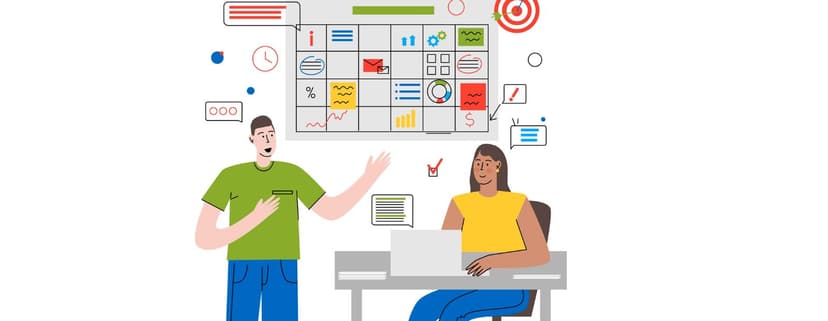Remarketing, also known as retargeting. It is a digital marketing strategy that shows ads to people who have visited your website or used a mobile app. The goal is to encourage them to take a action, such as buying your product or signing up for a newsletter.
Customers have become lazy and more skeptical than ever. B2B buyers especially take dozens of days to become a lead for a business. It takes more days for businesses' accounts to convert leads into customers. Considering B2B purchase size and cost, many buyers usually explore their options before making a purchase and many times give up before taking action.
Remarketing has proved a life savior in this scenario. Businesses that are fed up with losing customers right below the conversion stage are utilizing remarketing strategies in their advertising and content marketing campaigns. Many businesses have succeeded in recapturing their customers with a tailored and more personalized marketing approach that persuades them to complete their old abandoned actions.
Remarketing vs. Retargeting
Retargeting and remarketing are often used interchangeably, but they differ in their fundamental approaches. Initially, retargeting follows patterns of targeted ads that recapture audience attention through tailored display ads on different platforms like search engines and social media networks.
Remarketing targets people who have already shown interest in a business or brand. It uses first-party data to analyze the interests and behaviors of past visitors to their website. Therefore, remarketing is considered a broader term that follows multiple marketing channels to provide a holistic overview of remarketing.
The Common Remarketing Types
Some of the widely used techniques of remarketing strategies are:
Standard Remarketing
Standard remarketing is one of the common methods of conducting remarketing practices. This type works on targeting customers with tailored ads related to their previous search interests. It targets customers who have previously visited any brand’s site and recaptures customers through display network ads with the intent of reminding visitors about their products and services.
Standard remarketing not only operates based on users' social activities but is also influenced by their search engine interests and behaviors. This helps marketers make their efforts more personalized and persuasive.
Dynamic Remarketing
Dynamic remarketing is a more advanced form of creating a personalized digital experience for customers. It serves ads and experiences tailored explicitly to a single user. Dynamic remarketing for instance uses an approach such as re-capturing the interest of customers with the exact ad of a product that they browse from a website.
Dynamic remarketing uses a much more direct and relevant approach to customers. It also follows contextual advertising practices for example if a user reads a specific post or content on the website it will showcase an ad related to that content and topic.
Social Media Remarketing
Social media remarketing is one of the central forms of remarketing. Many fintech marketing campaigns are influenced by social media remarketing tactics. Social media remarketing operates on matching users' past social media interests by showing them tailored ads that remind them to buy. This type of remarketing comes with a more personalized approach and convinces users to engage with products and services more effectively.
Email Remarketing
Email remarketing campaigns aid in displaying ads based on user interaction and behavior with brands' emails. It works on displaying ads to people who have responded to certain email marketing campaigns, such as adding items to the shopping cart, or subscribing to a paid option.
Email remarketing strategies aim to create segments of the target audience and send them hyper-personalized marketing messages.
How Does Remarketing Help?
Some of the benefits of remarketing are:
Leverage The Presence of Site Visitors
Marketers invest tons of effort in bringing the site visitors to their website whether it is through organic marketing or paid advertising measures. Many times, users leave the website without giving any due attention. This hurts businesses' long-chain organic marketing efforts and often burns costs on advertising efforts too. Businesses can turn around this narrative through remarketing that sends tailored ads to visitors, arouses their interest, and encourages them to visit the site again.
Brings Back Lost Traffic
Bringing website traffic is not necessarily promised to bring the leads and conversions too. It's expected that most of the time, general website traffic doesn’t lead to the desired results such as earning leads or conversions. However, brands can leverage this relationship by recapturing their user's attention through targeted display ads when they browse different search engine display networks. This helps marketers pave the way for visitors to eventually move along the marketing funnel.
Increased Brand Recall
This is probably one of the major benefits that you can derive from remarketing – the act of bringing back to the attention of potential customers your brand even after they have left your website. Sometimes customers get to a site and either find something else that interests them or change their minds about purchasing a product. Remarketing creates an imprint of your product or service by advertising it on various platforms so that it can easily pull them back into consistent brand recall. This means that as people keep on interacting with your ads they will always associate your brands with your products whenever they are out to purchase a product.
Targeted Ad Personalization
Remarketing is the process of being able to target user based on their prior actions, which enables you to be very specific in the advertisements that you give. For instance, if a user visited your site concerned with a particular product but did not buy it, you can target the ad with a specific product that a user looked at with a promotion linked to it. This level of personalization also helps increase the chances of people clicking on the ad and also going back to your website to complete the purchase. Implementing personalized ads results in higher click-through rates and conversions.
Improved Conversion Rates
With remarketing, you are targeting users that already showed an interest in your business and, therefore, converting them is easier compared to when targeting cold audiences. Such users are already aware of your brand and all that it entails; they may require some form of convincing to push them to the next level. Whether they still require time to make decisions or if they are only waiting for the right opportunity, remarketing comes into the picture as the last hope of turning these warm leads into customers.
Cost-Effective Strategy
Therefore remarketing will too be cheaper than normal advertising because it targets users who already have a tendency to identify with your brand. Since you’re reaching out to users who have visited your website, the CPC or CPM rates are normally cheaper than other forms of display advertising. In addition, more of these users convert than the other users as, therefore, the exact ROAS for remarketing ads is normally higher.
Segmentation and Tailored Messaging
The second advantage of remarketing is the possibility of further segmentation according to the customers’ activity on the website. For instance, for users who left the shopping cart, users who visited your home page, or users who downloaded a resource, you can post several different advertisements. All these audience categories can be communicated with messages that suit specific types of behaviors. This sort of customization makes your ads unique and very appealing to the users hence making them sell more.
Cross-Platform Visibility
A remarketing campaign can be conducted through various media including Google Display Network, Facebook, Instagram, and many other social media or third-party sites. This is to make sure that the displayed ads will follow the users wherever they go online. Effectively using cross-platform consumer engagement is useful for keeping your brand out in the open and approaches to guide users back to your site. Integration across many places increases the likelihood of top-of-mind association and guides users to follow the conversion.
Wrapping Up
Remarketing is one of the best ways for businesses to capture customers. Often, along the marketing journey, brands usually struggle to convert their traffic into qualified leads or conversions. But with remarketing, brands have all the tactics to provide personalized user experiences to their targeted customers and eventually convert them into customers.






























